Tofu tempe bacem is a humble traditional Indonesian dish from Yogyakarta and Central Java. Like many other Javanese dishes, it has a sweet and savory flavor. You can eat this tahu and tempe bacem as a snack or with rice and vegetable dishes.

My mother’s hometown is Surakarta, a city in Central Java that most people know as “Solo.” We usually visit this city once a year and never miss a visit to its traditional market. You can easily find people selling tahu and tempe bacem, common street foods in that market.
Besides Solo, there is also one region famous for its tempe bacem, Kaliurang, in Yogyakarta. The tempe bacem famous in this region is paired with glutinous rice and coconut cake and is commonly known as “Jadah Tempe.” The contrast between flavor and texture becomes a special characteristic of this dish, as initially, this dish was not popular because it had no aesthetic value.
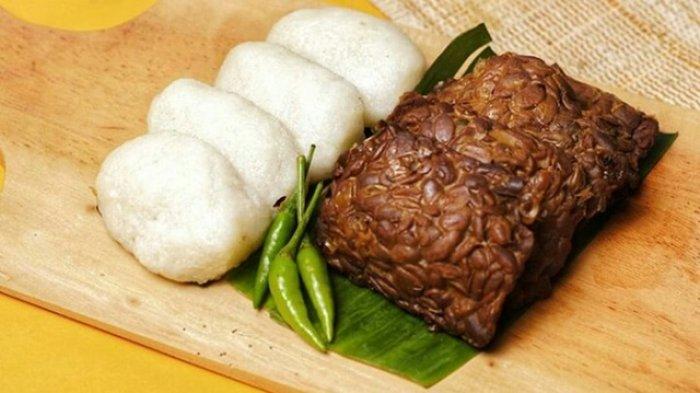
My mother also cooked this regularly when I was growing up. Compared with another Javanese cuisine, which usually involves multiple steps of cooking, I can say that this tofu tempe bacem recipe is pretty simple. There are two steps: the first one is braising them with all of the seasoning and palm sugar (where the sweet taste comes from). The second step is frying/baking tempeh or tahu/tofu to caramelize the surface. My mouth is drooling as I type this sentence.
Fast-forward: I’m living in Singapore now. There is no street vendor selling this, and my mother lives in Indonesia, so I have to make it myself. In this blog post, I will share my mother’s recipe so you can make it, too!
What is Tempeh?
Let me introduce you to this famous food from my home country! Tempeh (pronounced “tem-pay”) has been famous as a superfood for some time, but the cultured soy-based protein remains largely unfamiliar. In Indonesia, where tempeh originated, however, it’s widely used across the culinary landscape and is a celebrated staple of the everyday diet as an affordable and cheap protein source.
Tempeh is similar to tofu since they both are the result of the soybean fermentation process. However, there are some differences. Tempeh is made from cooked and fermented soybeans pressed into a cake, while tofu is made by curdling soy milk in a process similar to cheese-making. If you ask me what tempe tastes like, I would say tempeh has a chunky texture and a slightly nutty, mushroomy flavor. Tempeh is rich with umami flavor, giving it a savory meatiness, but it is also plain since it contains no salt.
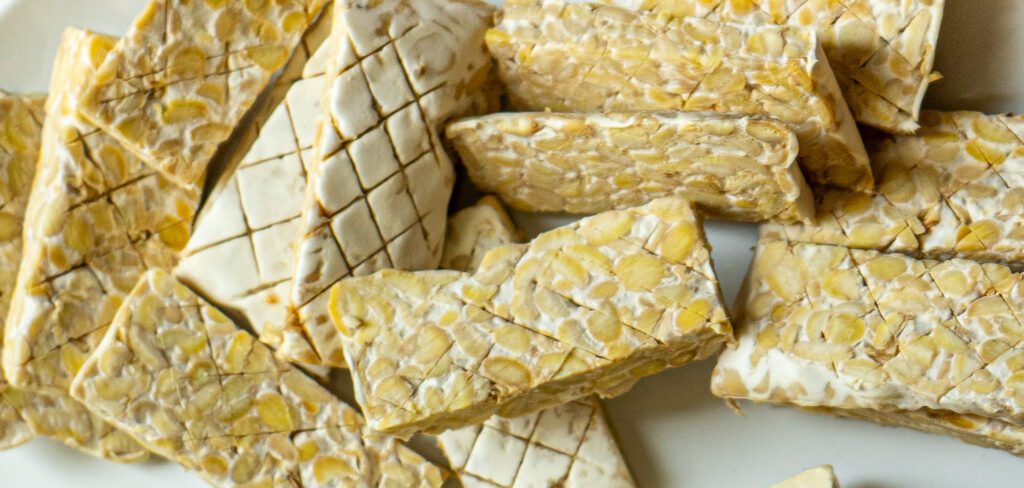
Tempeh is popular with vegans and vegetarians because it contains vitamin B12 and is a complete source of protein. It has all nine essential amino acids your body needs for healthy bones and muscles. In addition to being high in protein, tempeh is high in vitamins and minerals but low in sodium and carbs.
What is Bacem?
The first question you will have when you read this post is, “What is bacem? “Bacem is a traditional Javanese cooking method that involves braising food using spices and palm sugar and boiling it in a closed place until the water runs out. The result is moist, sweet, dark-colored tempeh or tofu.
One key thing to remember when making this bacem is to be patient for a yummy result! I highlight this point because the longer you braise your tofu and tempe using low heat, the more flavor will be infused into it. So try not to fasten up that process!
Another thing to add, even though tofu and tempe are the most popular ingredients for this bacem method, creativity should not stop there. Nowadays, people use this method to make chicken “ayam” bacem, which means that this method can be used for other vegan protein sources, such as mushrooms or other fake meat you prefer! I haven’t tried it yet, but I will update this post when I use another protein source.
What are the Ingredients for Tofu Tempe Bacem?
Tofu and Tempe
The main ingredients for this recipe are tofu and tempe. I tend to cut both on the thinner side. My mother would argue that this is not right since it will make it break easily during the braising process. In that sense, I admit she is right. I cut it into a thinner form because I can get more of the crunchy surface area when I fry them. However, I will also give you the measurements for the traditional size (my mother’s preference).
- Tofu: I will choose the firmer side, which will not break during braising. Cut it into 4cm x 4cm x 2cm (traditional) or 3cm x 3cm x 1cm (thinner version).
- Tempe: Use the regular block size tempeh. Cut it into 4cm x 2cm x 2cm (traditional) or 4cm x 2cm x 1cm (thinner version). Slice each of the surfaces of the tempe (refer to the picture below). The purpose is to make the seasoning infused into the tempeh better.
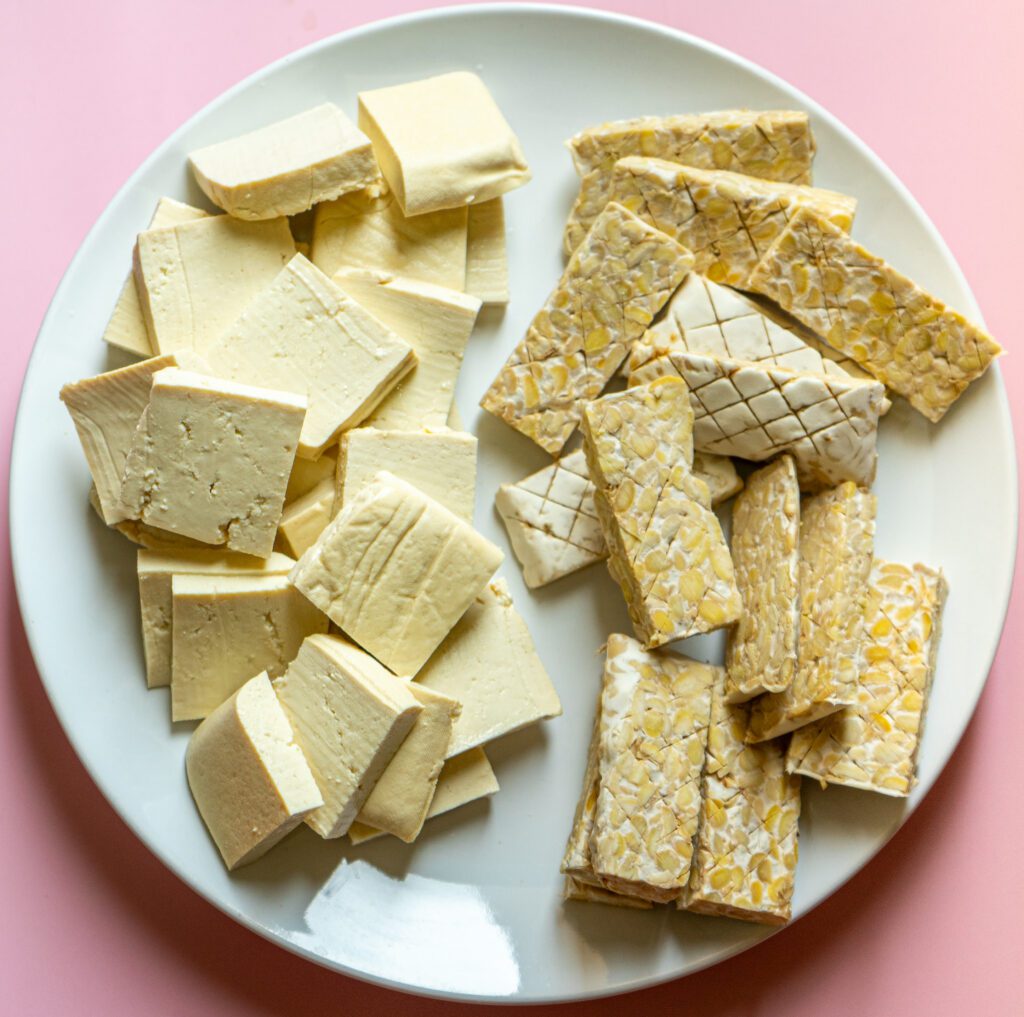

Blended Ingredients
- Shallot and Garlic: These two are the dynamic duo in Indonesian food. It’s pretty rare for Indonesian recipes to use one without the other. Garlic has a strong and pungent flavor, often used in savory dishes to add flavor and depth. Shallots have a milder flavor than garlic, with a hint of sweetness. It is important to have a proper balance of these two ingredients during cooking. For this recipe the ratio for the garlic and shallot is 1:2.
- Coriander seeds: Dry roasting or heating can enhance their flavor, aroma, and pungency; therefore, in this recipe, I sauté them without any oil to release the aromatic. I would avoid using ground or powdered seeds since they will lose flavor quickly, so they’re best fresh. This ingredient will add a mild citrusy hint with a slight curry flavor. If you don’t have coriander in your kitchen staples, try substituting it with cumin. FYI, there is no harm in storing coriander seed in your kitchen since it can be stored in an airtight jar for almost a year.
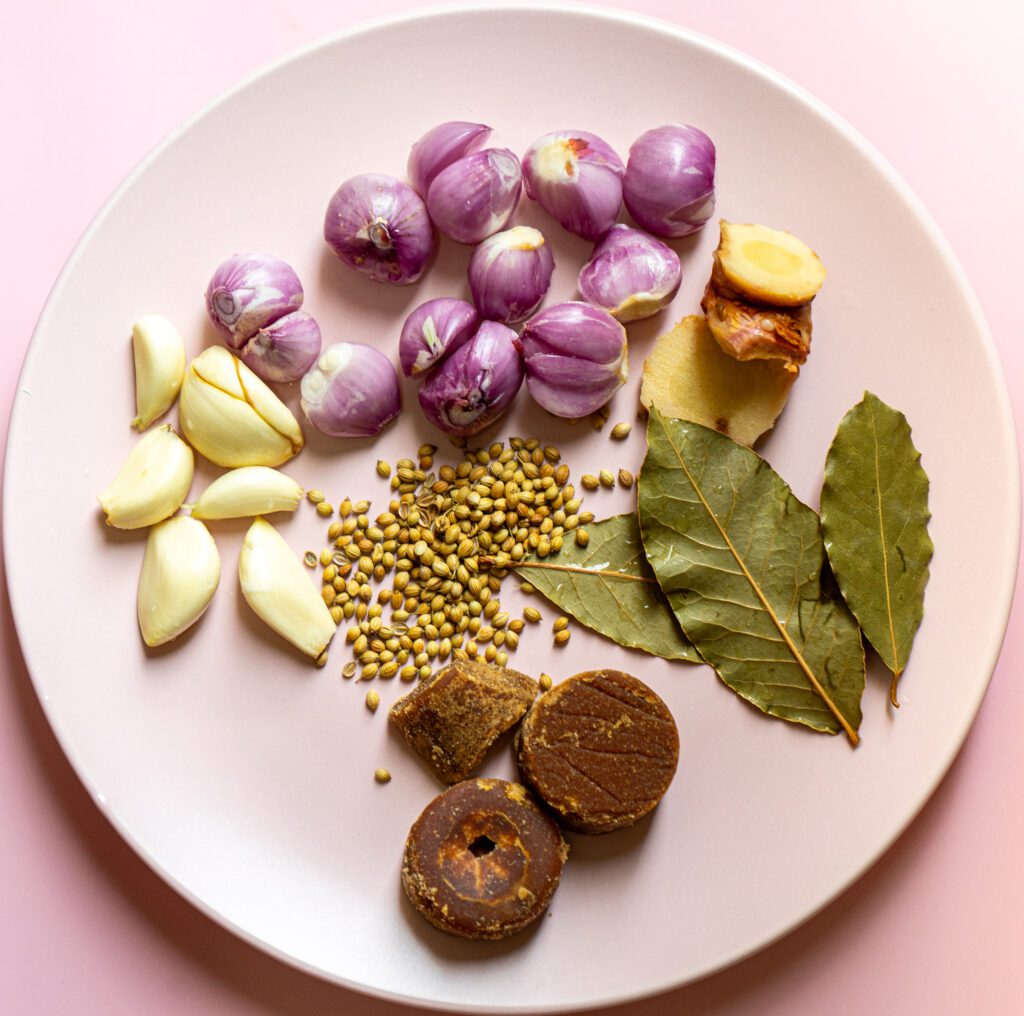

Other Ingredients
- Galangal roots: Galangal root is a relative of ginger and turmeric since they belong to the same family of plants. Despite belonging to the same family, there are significant differences in appearance, flavor, and texture between galangal and ginger. When young, galangal root is generally smoother and paler than ginger. Though galangal has a sharp taste, it is more citrusy, pine-like, and earthy, and some varieties have an almost minty, camphor-like scent and flavor. Ginger, on the other hand, is peppery with spicier notes. Galangal feels hard, woody, and fibrous, so cooks often discard it from dishes before serving. In this recipe, we won’t blend the galangal root but will boil them together with the other ingredients during the braising process. I will also slice the galangal root to increase the surface area.
- Bay leaves: I often wonder whether bay leaves addition to the recipe make a difference, so I googled and found this interesting article, “A Chef Settles the Debate: Do Bay Leaves Even Do Anything?”. So, if I can conclude based on my research, bay leaves infuse dishes with a woodsy flavor that also has subtle notes of eucalyptus and clove with the purpose of adding flavor and deepening existing flavor. Try not to omit it if you can!
- Palm sugar: This ingredient is important in this tofu tempe bacem recipe. I mentioned at the beginning of this article that tofu tempe bacem has a sweet and savory taste, and I can say that the sweet taste is coming from no other than this palm sugar! Palm sugar usually comes in block size; hence, you should shred it using a knife into smaller pieces to make it easy to dissolve.
- Salt and mushroom stock to taste
Let’s start making tofu tempe bacem
The cooking method consists of 3 steps: preparation, braising, and frying/ baking the tofu and tempeh.
1. Preparation
Make sure you have all of the key ingredients and did below steps:
- Cut and slice the tofu and tempe according to the guidelines in the Ingredient section of this block post
- Cut the galangal into multiple pieces and shred the palm sugar
- Blend the garlic, shallots, and coriander seeds together until smooth. I am using my immersion blender (here is the Amazon link for the type I use). If you don’t have the immersion blender, you can use any other spice blender (generally any blender that you can use to blend a small amount of the ingredients), or you can do it the traditional way by using the mortar and pestle—anything that will make these ingredients smooth. It is ok if the coriander seeds are not smooth.

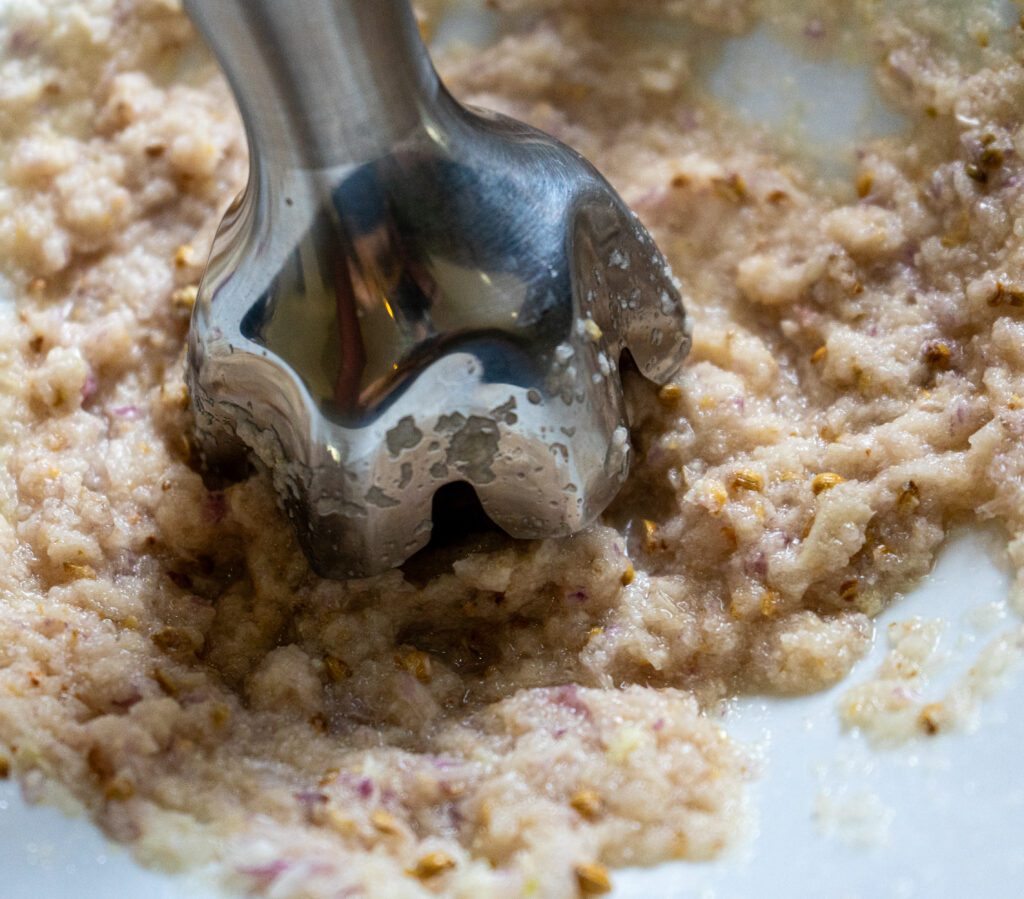
2. Braising
Put all of the blended ingredients and other ingredients (bay leaves, galangal, palm sugar, salt, and mushroom stock) into the pan. Add 500ml of water. Mix well until all of the palm sugar is dissolved.
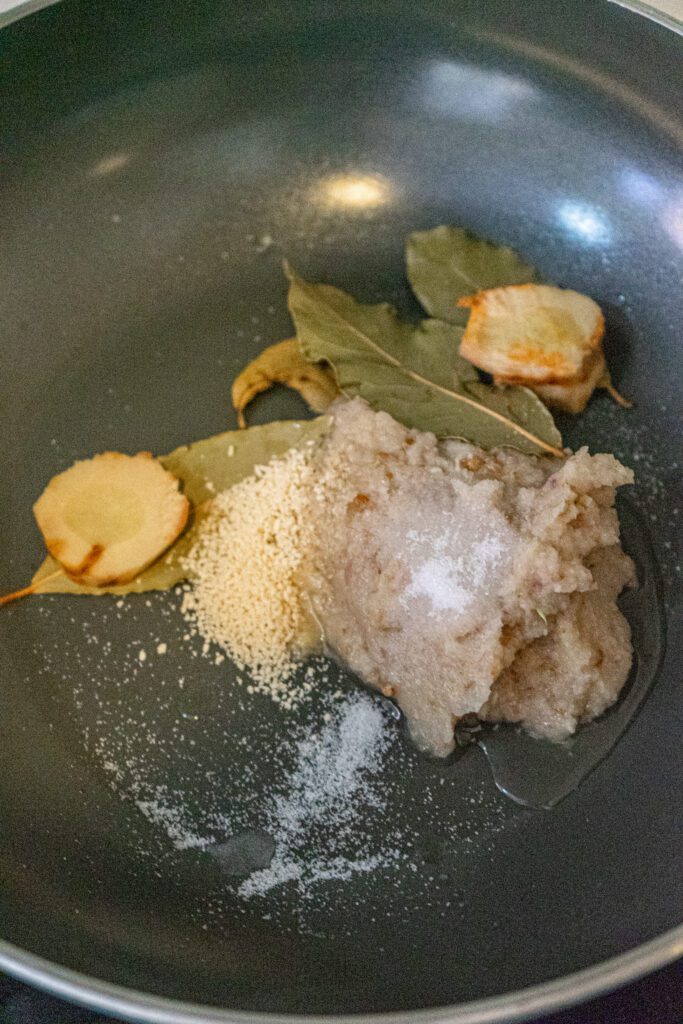


Put all of the tofu and tempeh into the pan. Make sure all of them are submerged. If not, you can put more water and then slowly mix the seasoning into the newly added water. After that, turn on the heat. We use low heat in order to slow down the braising process; therefore, the seasoning will infuse better into the tofu and tempeh. Flip the tofu and tempe occasionally. Make sure you do it carefully in order not to break the tofu or tempeh. Cover the pan 90% for better result (90% means that you need to open the cover slightly to let some of the steam escape)

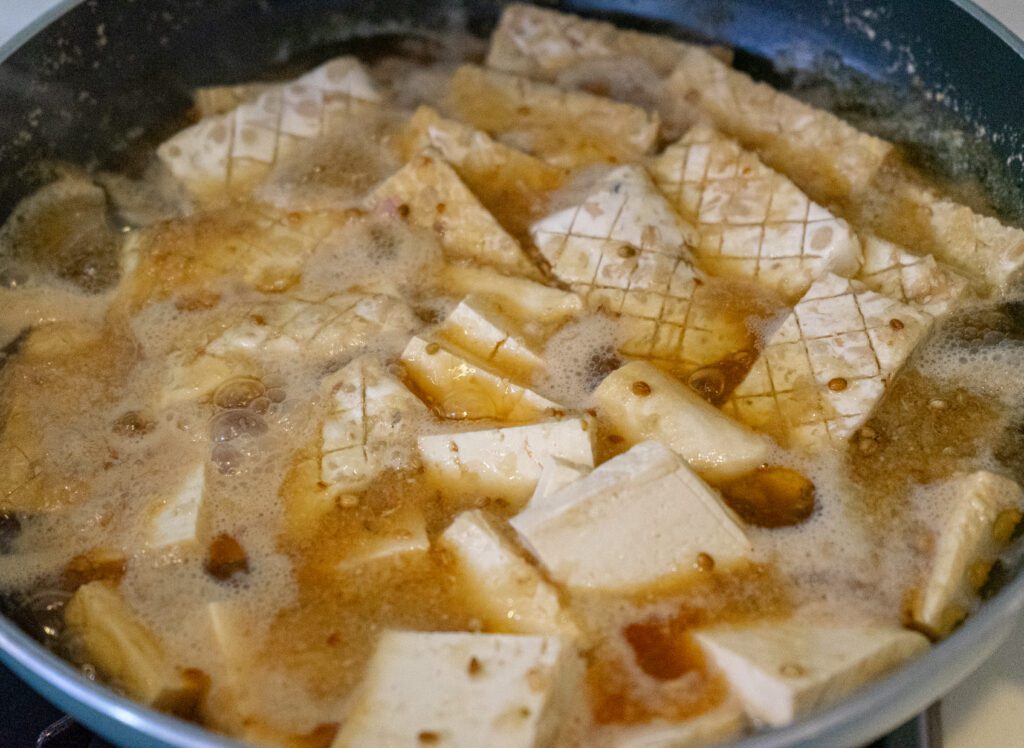
The water will become darker after a while. Continue flipping the tofu and tempe. Let it boil, and turn off the heat when all of the water has evaporated. Let it cool down and set it aside. At this stage, usually, I like to store the tofu and tempe bacem in an airtight container inside the fridge and then bake it or fry it at a later time when I want it.
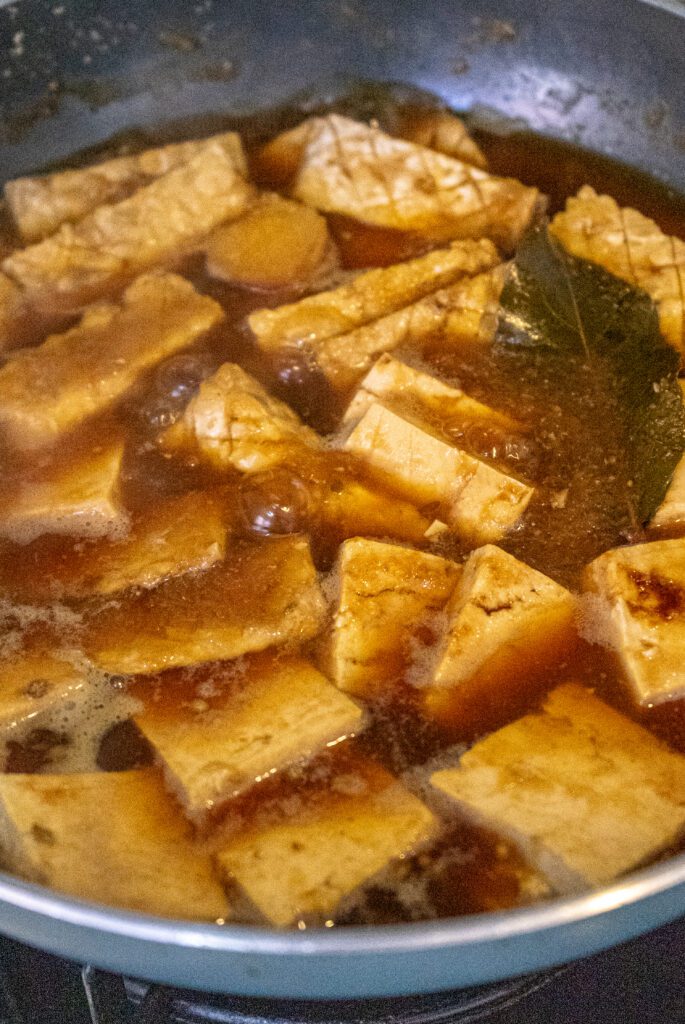
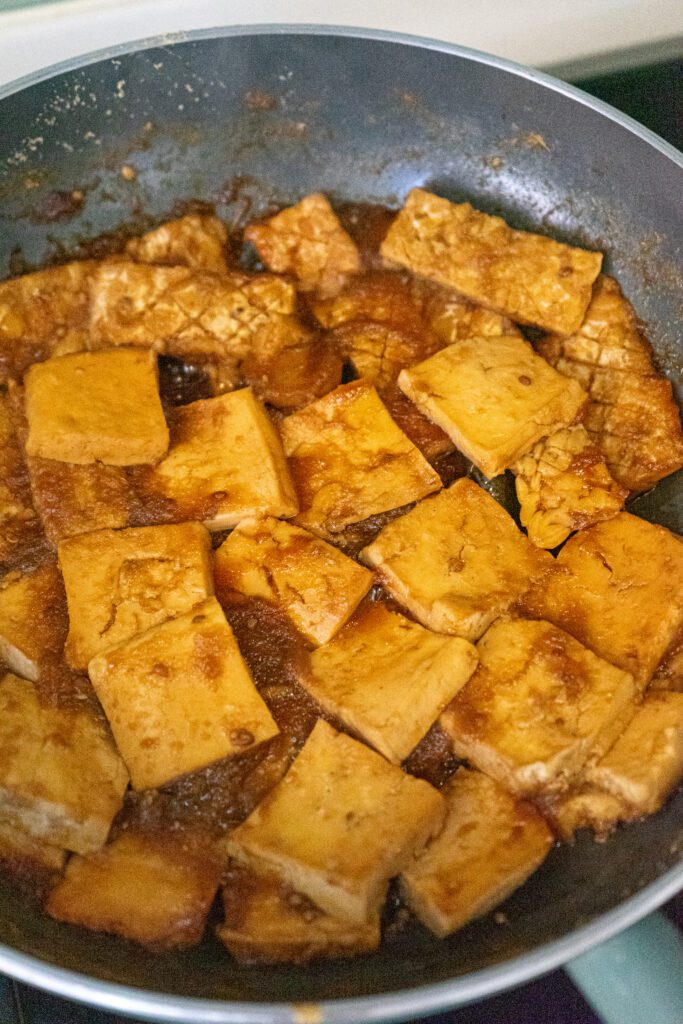
3. Frying or Baking the Tofu Tempeh Bacem
At this point, all of the tofu and tempe are already cooked. You need to fry or bake them to make them crunch and also to caramelize all of the seasonings on the surface of this tofu or tempe bacem.
- Air-fry them for 5-10 minutes at 180 degrees Celsius.
- Pan-fried them until all of the surface becomes lightly dark brown
- Bake them inside the oven for 5-10 minutes at 180 degrees Celsius.


Storing Instruction
You can store them in two ways:
- After braising, I recommend storing them in an airtight container in the fridge before frying or baking. They will last for 1-2 weeks. You can immediately put them into the pan/ oven whenever you want to consume them.
- After baking or frying them, I recommend storing them in an airtight container inside the fridge. They will last for 3-5 days.
Other recipes that you might like:
- Spiced Tofu in Banana Leaves (Pepes Tahu)
- Vegan Mushroom Satay with Peanut Sauce
- Vegan Mie Goreng (Fried Noodle)

Ingredients
- 200gr Tofu
-
200gr Tempe
Blended Ingredients
-
12 pcs Shallot
-
6 pcs Garlic
-
1 tbsp Coriander Seeds
Other Ingredients
-
50gr Palm Sugar
-
3pcs Bay Leaves
-
2cm galangal
-
Salt and Mushroom Stock
-
Water
Instructions
Preparation
- Cut and slice the tofu and tempe according to the guidelines in the Ingredient section of this block post
Cut the galangal into multiple pieces and shred the palm sugar
Blend the garlic, shallots, and coriander seeds together until smooth.
Braising
- Put all of the blended ingredients and other ingredients (bay leaves, galangal, palm sugar, salt, and mushroom stock) into the pan. Add 500ml of water. Mix well until all of the palm sugar is dissolved.
- Put all of the tofu and tempeh into the pan. Make sure all of them are submerged. If not, you can put more water and then slowly mix the seasoning into the newly added water. After that, turn on the heat. We use low heat in order to slow down the braising process; therefore, the seasoning will infuse better into the tofu and tempeh. Flip the tofu and tempe occasionally. Make sure you do it carefully in order not to break the tofu or tempeh. Cover the pan 90% for better result (90% means that you need to open the cover slightly to let some of the steam escape)
- The water will become darker after a while. Continue flipping the tofu and tempe. Let it boil, and turn off the heat when all of the water has evaporated. Let it cool down and set it aside. At this stage, usually, I like to store the tofu and tempe bacem in an airtight container inside the fridge and then bake it or fry it at a later time when I want it.
Frying or Baking the Tofu Tempeh Bacem
- At this point, all of the tofu and tempe are already cooked. You need to fry or bake them to make them crunch and caramelize all of the seasonings on the surface of this tofu or tempe bacem.
– Air-fry them for 5-10 minutes at 180 degrees Celsius.
– Pan-fried them until all of the surface became lightly dark brown
– Bake them inside the oven for 5-10 minutes at 180 degrees Celsius.
Notes
Storing Instruction
- After braising, before frying or baking, I recommend storing them in an airtight container in the fridge. They will last for 1-2 weeks. You can immediately put them into the pan/ oven whenever you want to consume them.
- After baking or frying them, I recommend storing them in an airtight container inside the fridge. They will last for 3-5 days.


1 comment
[…] Gulai Nangka (Jackfruit Curry) Recipe Spiced Tofu in Banana Leaves (Pepes Tahu) –… Tofu Tempe Bacem Recipe (Braised Tempe and Tofu)… Vegan Mushroom Satay with Peanut Sauce – Easy… How to Cook Indonesia Vegan […]
Comments are closed.